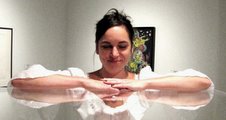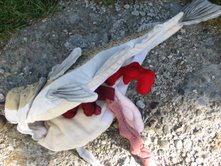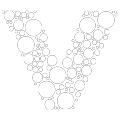

I’ve been living in Newfoundland for almost ten years now and I consider it home. It is in this province that I started to go to art school, starting with the Textiles Program at the Anna Templeton Centre in St. John’s in 2000. It was here that I learned how to weave, fulfilling a curiosity that has been with me since a child. While doing this program I became aware that I was more inclined to be part of the art world than the science world, having left Ontario and an uncompleted degree in Biological Science at the University of Guelph. After getting my diploma in Textiles I furthered my anthropological education by working at the Ship Pub for over three years, immersing myself in music, artists, performers and the downtown life of St. John’s. I moved to Corner Brook in 2005 to complete a Degree in Visual Arts and graduated this May, 2009.
Many people may see my work on display at various Interpretation Centres throughout Newfoundland and Labrador. These are codfish dolls that I designed for Parks Canada as part of their Making Fish Program. These soft-sculpture dolls are designed to be processed: ie. you cut off their heads, slice open their bellies, remove their guts and rip out their spines. Used to demonstrate the process of salting cod, there are over thirty of these codfish dolls floating around Newfoundland and I’ve recently been informed that they were used in a cooking class to show people how to fillet a cod before cooking it!
My most recent accomplishment is winning the 2009 Bank of Montreal First Art Award that is awarded to graduating visual arts students across Canada. My submission was a pink codfish doll that was made to generate dialogue in Toronto (where the show is held) about Newfoundland’s codfishing industry. I went to Toronto for the opening of this show in October at the Museum of Contemporary Canadian Art and had the pleasure of meeting fellow winners and art collectors who showed great appreciation for the codfish doll.
My favourite medium for sculptural work is metal, clay, porcelain and glass. I am practising my welding techniques in order to create large, sturdy sculptures that resist the elements of weather and time, much like humans do on our life journeys. The work I prefer to do is site specific installation pieces in nature that are built of natural materials in their natural settings, photographed and left to disintegrate over time. The ephermeral nature of this work fulfills my desire to be immersed in nature while making work that addresses the fleeting natural resources we have left and the time I have left with which to do it.
10 Questions
1. When did you first realise that you wanted to become an artist?
I don’t think you “become” an artist, rather you are predispositioned to creating obsessively or you are not. I’ve always spent a lot of time working with my hands, making constructions. Whether or not I am an artist depends on the viewer. At any rate, I’ve always done what I am doing now, I just pick up more skills and experience as I age…
2. What mediums do you work in, and why?
I work in metal, textiles, clay and natural materials for my sculptural forms and I prefer screen print and wood block printing when I am making 2D work. I use screen printing because I like the texture and feel of pushing and pulling the thick inks across the screen, and wood block printing is a meditative process involving natural elements that fulfills my need to be linked to my materials. Right now I am keen to make multiples of my work as I have an obsessive practical streak that requires me to perfect a technique and prove it by repeating the process over and over again. I like print making as it is quite a sculptural process and I am waiting until I am old and more immobile to practice my drawing technique. While I am young I prefer the physical labour of sculpture and labour-intensive processes as such. I do not like to sit or stand still for long periods of time so I will pursue these forms now, while I am strong and healthy, and save painting and drawing for when I get older and calm down more.
3. How do you get ideas for your artwork?
They come to me constantly in everything I do, see, hear or watch. It is natural for me to take anything I read, feel or think and try to turn those feelings into something tangible.
4. What other artists influence your artwork?
The original native people of North America who made beautiful things for the sake of things being beautiful, practical and functional influence me far more than any contemporary artist today.
5. What are the ‘big’ themes in your artwork?
Respect for nature, respect for the history and work of those people that came before me. Things that disturb me or memories that need to be revered make up the content of much of my work.
6. What is the greatest challenge that you face as an artist working in Newfoundland and Labrador?
Having to wake up at 3:30am to fly out of here is a pain, but a small one.
7. What is the best thing about working as an artist in this province?
The geographical and mental space available to me in Newfoundland and Labrador is liberating. Here I can think clearly and without much of the nonsense found in massive cities. There is solitude here…
8. Where do you see yourself in 10 years?
Let the winds blow me where they may…
9. If you weren’t an artist, what would you be doing?
I’d rather not say…
10. If you could have one wish granted, what would it be?
Harmony around the block. Also, I wouldn’t mind being invisible with the ability to travel back and forth through time….
